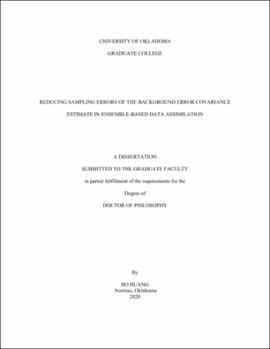| dc.description.abstract | Ensemble-based data assimilation (DA) estimates forecast error in a flow-dependent fashion, in contrast to the traditional variational DA assuming static forecast error. Due to computational constraints, however, accuracy of the ensemble background error covariance estimate is compromised by sampling error. Direct increase of ensemble size contributes to reducing sampling error, but the increased computational cost can be prohibitive especially for operational numerical weather prediction (NWP) applications. On the other hand, the localization is commonly applied to reduce or eliminate distant spurious correlations caused by sampling error. But the localization can cause additional imbalance in the analysis and potentially eliminate some distant realistic signal. Therefore, efficient treatment of sampling error remains a challenge for the ensemble-based DA. This dissertation covers three topics of efficiently reducing sampling error and further improving background error covariance estimate in the ensemble-based DA.
Firstly, a valid-time-shifting (VTS) ensemble method is introduced as cost-efficient means to increase ensemble size. The VTS method, either in form of full ensemble members (VTSM) or ensemble perturbations (VTSP), is implemented and examined in the National Centers for Environmental Prediction (NCEP) Global Forecast System (GFS) hybrid four-dimensional ensemble-variational (4DEnVar) DA system. VTSM and VTSP applying a single shifting time interval (e.g., one, two or three hours) triple the baseline background ensemble size from 80 to 240 in the EnVar update, while the overall cost only increases by 23%-27% depending on the selected shifting time interval. Ten-week cycled DA experiments show that VTSP generally improves global temperature and wind forecasts to 5 days over running the original 80-member ensemble. VTSM generally degrades global forecasts in the troposphere. Both VTSM and VTSP improve tropical storm track forecasts over running the original 80-member ensemble. In particular, three-hour VTSM even shows more accurate tropical storm track forecasts than directly running a 240-member ensemble. Further diagnostics are conducted to understand the potential cause of their different performances.
Secondly, two localization methods commonly applied in the ensemble Kalman filter (EnKF) are mathematically examined and compared, that is, the B-localization method that performs the localization on the background error covariances, and the R-localization method that inflates the observation error variances. Mathematical demonstration suggests that the B-localized background error covariance matrix shows higher rank than the R-localization method. The B-localization method is further realized in the ensemble transform Kalman filter (ETKF) by modulating and extending the background ensemble perturbations. The B-localized ETKF is termed as the high-rank ETKF (HETKF) to distinguish from the classic R-localized ETKF. Cycled DA experiments using the Lorenz model II show that the HETKF outperforms the R-localized ETKF especially for a small ensemble, which is likely associated with the higher rank from the B-localization method.
Lastly, the simultaneous multi-scale DA capability is developed in the GSI-based global hybrid 4DEnVar system by introducing scale-dependent localization (SDL) with and without considering cross-waveband covariances (i.e., SDL-Cross and SDL-NoCross, respectively). SDL applies a different amount of localization to different scales of ensemble background error covariances, while performing a single-step simultaneous assimilation of all the available observations. One-month cycled DA experiments using the NCEP Finite-Volume Cubed-Sphere Dynamical Core (FV3)-based GFS model show that both SDL-NoCross and SDL-Cross improve general global forecasts to five days over applying fixed uniform localization once at all scales. By including the cross-waveband covariances, SDL-Cross tends to show more accurate global forecasts and tropical storm track forecasts than SDL-NoCross at longer forecast lead times. Compared to the two-waveband SDL experiments, the three-waveband SDL experiment counterparts applying tighter horizontal localization at medium-scale waveband generally show improved (degraded) global forecasts below (above) 50 hPa, except the outperformance of the three-waveband SDL-Cross experiment over the two-waveband SDL-Cross experiment below 50 hPa only lasts for three days. In addition, the three-waveband SDL-Cross experiment even shows more accurate tropical storm track forecasts than the experiment applying the operational level-dependent localization at shorter forecast lead times. Diagnostics are further performed to understand their different performances. | en_US |
